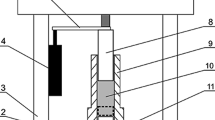Summary
The total resistance to transfer through a hydrophobic membrane used in the tubing method is due to an external liquid film and to the membrane itself. The global mass transfer coefficient is higher for alcohols than for other tested volatiles. PTFE microporous membranes are recommended.
Similar content being viewed by others
References
Phillips D.H., Johnson M.J. (1963), Biotechnol. Microbiol. Technol. Eng., 3, 261
Yano T., Kobayashi T., Shimizu S. (1978), J. Ferment. Technol. 56, 421
Yamane T., Matsuda M., Sada E. (1981), Biotechnology and Bioengineering, 23, 2493–2507
Pons M.N., Ducouret P., Bordet J. (1985), Entropie, 123, 21
Author information
Authors and Affiliations
Rights and permissions
About this article
Cite this article
Pons, M.N., Ducouret, P. & Engasser, J.M. Mass transfer characteristics of hydrophobic tubing membrane sensors. Biotechnol Lett 8, 407–410 (1986). https://doi.org/10.1007/BF01026741
Issue Date:
DOI: https://doi.org/10.1007/BF01026741




